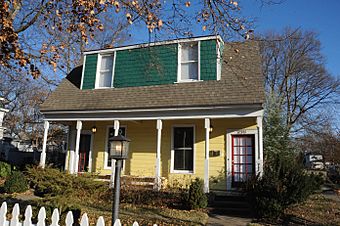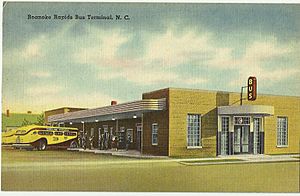Roanoke Rapids Historic District facts for kids
Quick facts for kids |
|
|
Roanoke Rapids Historic District
|
|

Turtleback House
|
|
| Location | Roughly bounded by Roanoke R.; Charlotte, Marshall, and Jefferson Sts.; CSX RR; and W. Thirteenth, Rapids, and Henry Sts, Roanoke, North Carolina |
|---|---|
| Area | 0 acres (0 ha) |
| Architect | Aladdin Company; Upjohn, Hobart, et al. |
| Architectural style | Queen Anne, Bungalow/craftsman, Colonial Revival |
| NRHP reference No. | 98001574 |
| Added to NRHP | April 27, 1999 |
The Roanoke Rapids Historic District is a special area in Roanoke Rapids, North Carolina. It's located in Halifax County, North Carolina. This district is important because it protects many old buildings, sites, and structures. They help tell the story of Roanoke Rapids.
The district includes 1,130 buildings, 5 sites, and 27 structures that are part of its history. You can see different styles of architecture here. These include the fancy Queen Anne style, the classic Colonial Revival style, and the cozy Bungalow / American Craftsman style.
Contents
What is a Historic District?
A historic district is a group of buildings, structures, or places that are important because of their history or architecture. When an area becomes a historic district, it means people want to protect its unique character. This helps keep the past alive for future generations.
Buildings in the District
Many interesting buildings are part of the Roanoke Rapids Historic District. One important building is the Roanoke Rapids High School, which is also listed separately as a historic place.
Other notable buildings include:
- Old houses where mill workers used to live.
- The Driscoll-Piland-Webb House, built around 1897.
- The Dickens-Webb House, built in 1906-1907.
- The First Presbyterian Church, built in 1915.
- All Saints Episcopal Church, designed by a famous architect named Hobart Upjohn in 1917.
- The former United States Post Office, built in 1937-1938.
- The Imperial Theatre Building, which opened in 1919.
- Old factory buildings like the Rosemary Manufacturing Company complex.
This district was added to the National Register of Historic Places in 1999. This list helps recognize and protect important places across the United States.
The Carolina Trailways Bus Station
The former Carolina Trailways Bus Terminal is located at 1114 Roanoke Avenue. This building was the site of a very important event in American history. This event led to a major case in the U.S. Supreme Court called Keys v. Carolina Coach Co..
A Fight for Fairness
On August 1, 1952, a young African American woman named Sarah Keys was riding a Carolina Trailways bus. When the bus stopped in Roanoke Rapids, she was told to move from her seat to a different section of the bus because of her race. This was part of unfair rules called "segregation" that separated people based on their skin color, especially in public places like buses.
Sarah Keys bravely refused to move. Because she refused, she was arrested and had to spend the night in jail in Roanoke Rapids. She was also fined $25.
The case of Keys v. Carolina Coach became very important. In 1955, the U.S. government ruled that segregation on buses that crossed state lines was illegal. Then, in 1961, Attorney General Robert F. Kennedy used this ruling to help end unfair travel rules during the Freedom Riders' campaign. The Freedom Riders were people who rode buses together to challenge segregation.
The Bus Station Building
The bus station building itself is also interesting. It was built in 1941 in a style called Streamline Moderne. This style looks smooth and sleek, like a fast train or car. The building was used as a bus station until the 1970s. In 1998, it was recognized as an important part of the historic district.




